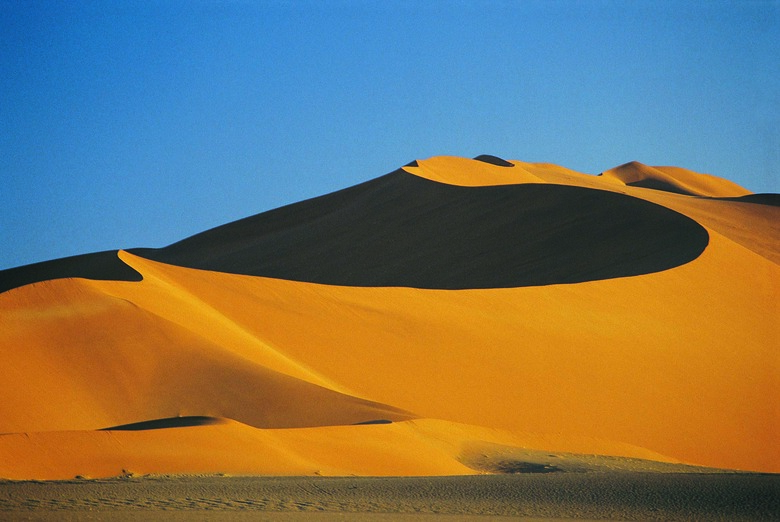What Is The Difference Between Deflation & Saltation?
A gentle breeze is refreshing in spring and cooling on a humid day, but wind is not always so helpful. It can cause erosion, which moves soil from place to place. This raises a host of problems, including loss of vegetation, air pollution and reduction in soil nutrients. Wind erosion comes in several forms. When fine particles are shifted, the process is called deflation. Saltation relocates larger grains. Both processes cause damage.
Tiny Specks
Tiny Specks
During deflation, small particles of sediment or soil are moved by the wind. Clay, silt and fine sand are often moved by this process. Deflation sometimes occurs because plant life has been destroyed in an area, such as through fire or human overuse. Plants give the earth some protection from the wind. The amount of water in soil can affect the level of deflation, because wet soil is harder for the wind to carry away. In addition, moisture encourages the growth of protective plants.
Big Changes
Big Changes
Deflation causes several types of natural formations. In sandy coastal regions, wind removes the top layer of fine, dry sand, leaving wet sand behind. The water in the sand encourages vegetative growth, resulting in a deflation plain. The plant growth may eventually spread to other areas. If the left-behind material has limited moisture, the area becomes a desert pavement. Sometimes, in areas without moisture or vegetation, the wind scoops out matter, leaving dips in the landscape. These deflation hollows, or blowouts, can be symmetrically or irregularly shaped. They vary dramatically in depth and width. For example, in the Great Plains, some depressions are small and shallow, while others leave a hollow more than 45 meters deep and several kilometers wide.
Following the Bouncing Particles
Following the Bouncing Particles
In contrast to deflation, saltation moves medium-size particles about 0.1 to 0.5 mm in diameter. The wind carries these bits just above the surface. The particles travel for a short distance and then fall to the ground. There they dislodge other grains, causing them to bounce. Saltation accounts for 50 to 80 percent of soil movement. If the falling specks strike particles too large to pop up, they may still be edged forward. In the desert, 25 percent of particle dislocation is caused by this slow push forward.
Dark Clouds
Dark Clouds
Under the right conditions, saltation can move a lot of soil. With continual wind and enough loose particles, a soil avalanche can occur. This thick haze of soil grains looks like a dirt cloud carried by the wind over the ground. In agricultural regions, cultivation on windy days increases the amount of saltation. More soil is exposed, so more erosion occurs. Saltation is a significant problem on farms; it is the principal source of damage to vegetation. Wind shelters, reduced tillage, well-maintained irrigation and protective ridges within fields reduce this form of erosion.
Cite This Article
MLA
Sherwood, Susan. "What Is The Difference Between Deflation & Saltation?" sciencing.com, https://www.sciencing.com/difference-between-deflation-saltation-12336232/. 24 April 2017.
APA
Sherwood, Susan. (2017, April 24). What Is The Difference Between Deflation & Saltation?. sciencing.com. Retrieved from https://www.sciencing.com/difference-between-deflation-saltation-12336232/
Chicago
Sherwood, Susan. What Is The Difference Between Deflation & Saltation? last modified March 24, 2022. https://www.sciencing.com/difference-between-deflation-saltation-12336232/
